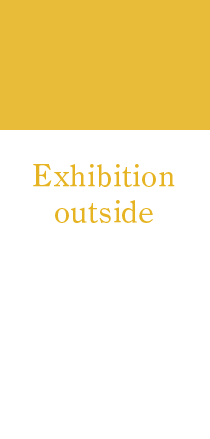2024.02.21(Wed)〜2024.02.25(Sun)
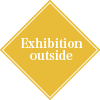

2024.02.21(Wed)〜2024.02.25(Sun)

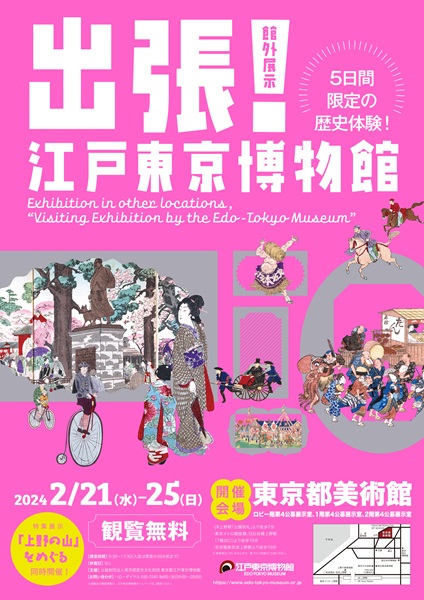
The Edo-Tokyo Museum opened its doors on March 28, 1993, as a space to reflect on the history and culture of Edo-Tokyo and to envision the city and life in the future. Since then, we have had many visitors not only from Japan but also from all over the world.
Thirty years have passed, and now we are undergoing a major renovation, for which reason we will be closed until sometime in FY2025 (scheduled). However, we are pleased to announce that we will be holding an exhibition to showcase some of our permanent collections at the Tokyo Metropolitan Art Museum in Ueno.
The exhibition will present a part of our permanent exhibitions across the LB and 1st floors. The exhibits include our popular interactive replicas such as the “Box for gold coins” and “Rikshaw,” and other related materials.
There will also be a special exhibition on the 2nd floor, which introduces the history of Ueno, where the exhibition is held, through nishiki-e (colored woodblock prints) and postcards. It shows scenes that look very similar to the present, such as the bronze statue of Saigō Takamori and Shinobazu Pond, which are still symbols of Ueno to this day. Visitors might find that they have spotted some of the landmarks shown in this exhibition on their way to the venue.
We hope these exhibitions will provide an opportunity to experience the charm of the Edo-Tokyo Museum, as well as the history and culture of Edo-Tokyo, through a wide range of our collections.
| Date | February 21 (Wed) - 25 (Sun), 2024 |
|---|---|
| Venue | Tokyo Metropolitan Art Museum LBF Citizen’s Gallery 4, 1F Citizen’s Gallery 4, 2F Citizen’s Gallery 4 |
| Access | 7 min walking from JR Ueno Station “Park Gate” 10 min walking from Ueno Station “Exit 7”, Tokyo Metro Ginza Line and Hibiya Line 10 min walking from Keisei Line Keisei Ueno Station *No parking area, so please refrain from coming by car. |
| Exhibition Hours | 9:30 – 17:30(Last admission 17:00) |
| Closed | None (Open every day during exhibition period) |
| Organized by | Tokyo Metropolitan Edo-Tokyo Museum operated by Tokyo Metropolitan Foundation for History and Culture |
| Admission | Free |
| Contact | 050-5541-8600(9:00 – 20:00) |
Exhibition Flyer (PDF/6.95MB)
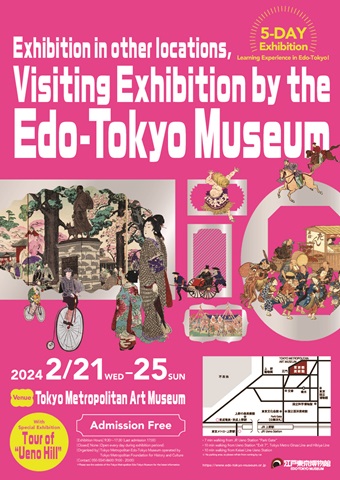 |
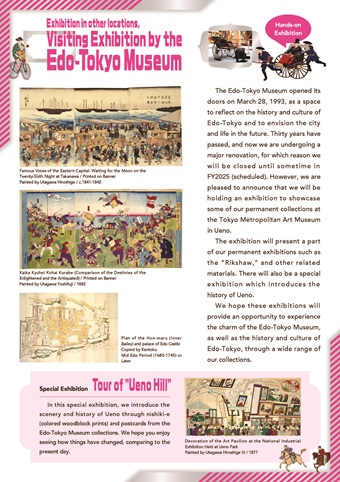 |
List of Works
Introducing works from the permanent exhibitions The Edo-Tokyo Museum’s permanent exhibitions consist of 20 thematic sections and are largely divided into two zones: Edo and Tokyo. For this time, we have selected materials from three sections of Edo zone (Edo Castle and the District Zones, Life of the Townspeople, and Commerce of Edo) and two sections of Tokyo zone (Behind the Scenes of “Enlightenment”, and Tokyo and the Industrial Revolution). Visitors can enjoy the essence of our permanent exhibitions.
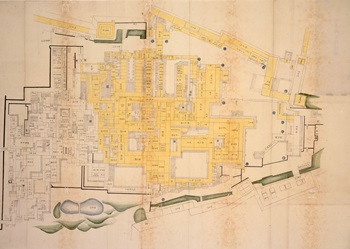
Plan of the Hon-maru (Inner Bailey) and palace of Edo Castle |
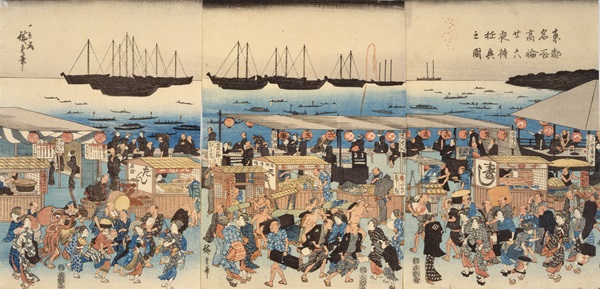
Famous Views of the Eastern Capital: Waiting for the Moon on the Twenty-Sixth Night at Takanawa/ Printed on Banner |
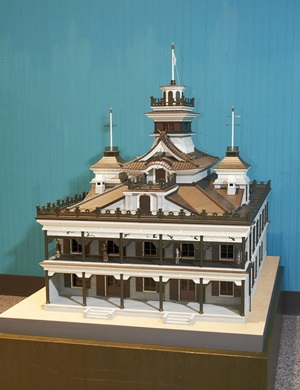
First National Bank/ model |
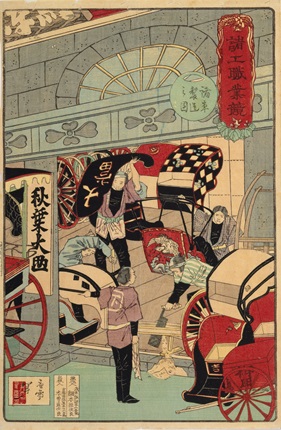
A Comparison of Craftsmanship: Carriage Maker / Printed on Panel |
Many people may think of some interactive replicas when they hear the name of the Edo-Tokyo Museum. In this exhibition, we will showcase our popular interactive replicas such as Rickshaw, Box for gold coins, Tricycle, and other related materials.
|
Rickshaw (a man-pulled cart) / replica |
Box for gold coins/ replica |
Perhaps for many people, Ueno is associated with museums, art, cherry trees and cherry blossom viewing. The area around Ueno Park is also called “Ueno Hill,” since it is located on a hilly terrain, on the Musashino Plateau.
Similarly to the present day, Ueno was famous for its cherry blossoms in the Edo period; however, the area looked very different from now, as it was bristling with temples, including Kan’ei-ji Temple and its sub-temples. Ueno was also regarded as a religious, sacred site for the Tokugawa Shogunate family, as they built Ueno Tōshōgū Shrine near Kan’ei-ji Temple.
During the Battle of Ueno in 1868, however, Ueno was burnt to the ground and most of Kan’ei-ji Temple was lost in the fire. Originally there was a plan to build a hospital on the same location, but a Dutch doctor Bauduin, who came to inspect the site, suggested to build a park; thus, Ueno Park was constructed and designated as a public park in 1873. Following that, in 1877, the 1st National Industrial Exhibition was held in Ueno, which established Ueno as a cultural hub for hosting numerous expositions and exhibitions. As a result, a cluster of cultural and educational facilities such as art galleries and museums were built in Ueno. This has captivated many people, making Ueno a place to enjoy art and culture.
In this special exhibition, we introduce the scenery and history of Ueno through nishiki-e (colored woodblock prints) and postcards from the Edo-Tokyo Museum collections. We hope you enjoy seeing how things have changed, comparing to the present day.
|
One Hundred Famous Views of Edo: Kiyomizu-do Temple and Shinobazu Pond, Ueno |
|
Picture Scroll of Tokugawa Ienari’s Funeral Procession/ Part of a Picture Scroll |
|
Bronze Statue of Saigō Takamori at Sannōdai in Ueno |
|
Decoration of the Art Pavilion at the National Industrial Exhibition Held at Ueno Park |
We provide free memorial cards exclusively for visitors! These 10 types of cards picture collections from the exhibition and will be distributed at random.

*Contents of workshops may be changed without notice
No Reservation Required In order of Arrival
|
Our curators will explain the structure and history of samurai armors. Visitors can touch replicas of armors and feel the materials and weights. |
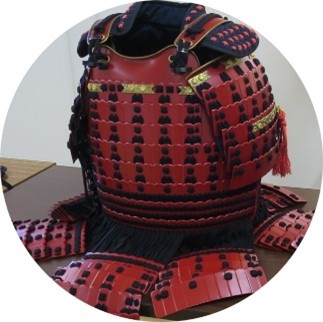 |
| Date | February 23 (Fri), 2024 ① 11:00 AM – ② 2:00 PM - |
|---|---|
| Capacity | 15 people per session |
| Admission | Free |
|
Monkiri (paper-cutting) was one of popular plays among Edo’s children. |
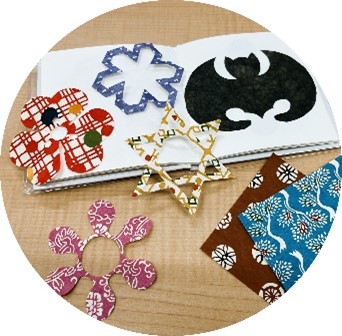 |
| Date | February 24 (Sat), 2024 ① 11:00 AM – ② 2:00 PM – |
|---|---|
| Capacity | 15 people per session |
| Admission | Free |
As we will use scissors at this workshop, attendance of adults is required for young participants who are elementary school children or younger.
We introduce highlights of the Special Exhibition: Tour of “Ueno Hill”!
| Date | February 22 (Fri), 2024 2:00 -3:30 PM |
|---|---|
| Venue | Auditorium at Tokyo Metropolitan Art Museum |
For Edohaku Culture’s further information including application methods and participation fee, please refer to the website or leaflet of the Tokyo Metropolitan Edo-Tokyo Museum.
